27.07.2019
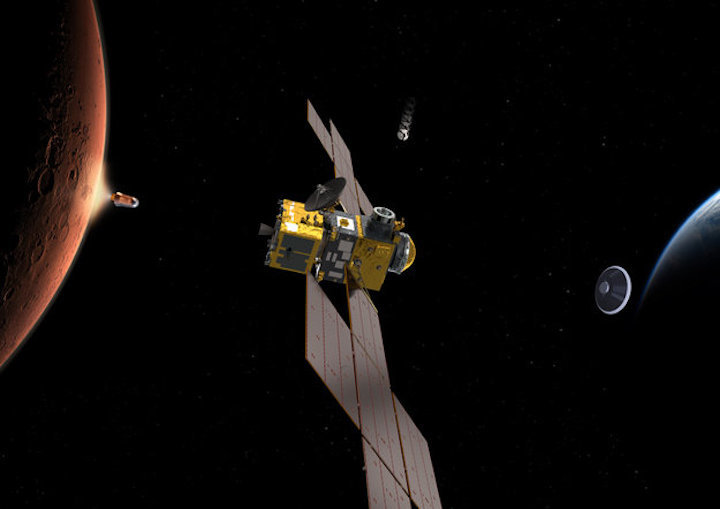
EUROPE PREPARES FOR MARS COURIER
The first round-trip to the Red Planet will see a European orbiter bringing martian samples back to Earth. ESA is opening the door to industry to build the spacecraft that will deliver the precious rocks, dust and gas from Mars – the key to understanding whether life ever existed on our closest planetary neighbour.
This ‘take-away’ service is called the Earth Return Orbiter, and will be ESA’s major contribution to the Mars Sample Return campaign. The ESA Orbiter will carry NASA’s Capture and Containment and Return System, which will rely on the ESA-led spacecraft for transit to and from Mars.
Three launches from Earth and one from Mars – the first ever from another planet –, two rovers and an autonomous capture in Mars orbit are all part of an ambitious series of missions that ESA is embarking on together with NASA.
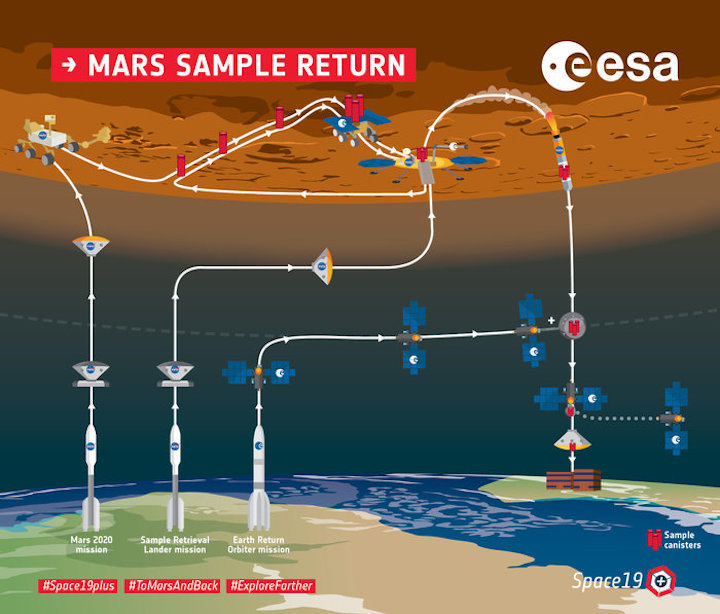
Overview of the ESA–NASA Mars Sample Return mission.
Bringing samples from Mars is the logical next step for robotic exploration and it will require multiple missions that will be more challenging and more advanced than any robotic missions before. Accomplishments in robotic exploration in recent years have increased confidence in success – multiple launches will be necessary to deliver samples from Mars.
ESA is working with NASA to explore mission concepts for an international Mars Sample Return campaign between 2020 and 2030.
Three launches will be necessary to accomplish landing, collecting, storing and finding samples and delivering them to Earth.
NASA’s Mars 2020 mission will explore the surface and rigorously document and store a set of samples in canisters in strategic areas to be retrieved later for flight to Earth.
Two subsequent missions are foreseen to achieve this next step.
A NASA launch will send the Sample Retrieval Lander mission to land a platform near the Mars 2020 site. From here, a small ESA rover – the Sample Fetch Rover – will head out to retrieve the cached samples.
Once it has collected them in what can be likened to an interplanetary treasure hunt, it will return to the lander platform and load them into a single large canister on the Mars Ascent Vehicle (MAV). This vehicle will perform the first liftoff from Mars and carry the container into Mars orbit.
ESA’s Earth Return Orbiter will be the next mission, timed to capture the basketball-size sample container orbiting Mars. The samples will be sealed in a biocontainment system to prevent contaminating Earth with unsterilised material before being moved into an Earth entry capsule.
The spacecraft will then return to Earth, where it will release the entry capsule for the samples to end up in a specialised handling facility.
ESA and NASA are exploring the concepts for these missions, with ESA assessing the Sample Fetch Rover and Earth Return Orbiter. These will provide input to ESA’s 2019 council at ministerial level, where approval will be sought for the missions.
The campaign aims to bring at least 500 grams of samples back from the Jezero crater that once held a lake and contains an ancient preserved river delta. The rocks in the area preserve information about Mars’ diverse geology.
NASA’s Mars 2020 rover that is slated for launch in July 2020 will scientifically select the best samples to store in tubes and deposit them onto the martian surface for later retrieval.
ESA is also studying concepts for a small ‘fetch’ rover to scurry quickly across the martian surface to locate and recover the stored samples.
It would then carry them back to a football-sized canister that would be launched with a NASA Mars Ascent System – a small rocket.
The Earth Return Orbiter will capture the canister in orbit and transfer it safely to Earth, a return trip that will take about 13 months.
“We will have the responsibility of finding, capturing and transporting these precious martian treasures home for careful analysis in state-of-the-art labs on our planet,” explains Sanjay Vijendran, ESA’s Mars Sample Return campaign coordinator. “It’s an interplanetary treasure hunt!”
Bringing Mars back to Earth
The Earth Return Orbiter is set to get onto the launch pad by 2026 from Europe’s spaceport in Kourou, French Guiana. Through this call, ESA will be selecting a prime contractor for the spacecraft.
“The mission is becoming a reality, and we are proud to give European industry the chance to join the challenge,” says Orson Sutherland, study manager for the Earth Return Orbiter.
The main challenges are the electric propulsion and power generation. “Not to forget finding and navigating the spacecraft to rendezvous with the football sized orbiting sample over 50 million km away from ground control,” adds Orson.
The spacecraft will use technological heritage from ESA’s most recently launched science mission, BepiColombo: both use electric propulsion and multi-stage detachable modules.
“Europe is ready to do its bit for the Mars Sample Return campaign, in close partnership with NASA, and is up to the challenge of putting the spacecraft onto the launch pad in 2026,” says Orson.
Quelle: ESA
----
Update: 30.07.2019
.
Bringing Pieces of Mars to Earth in 2031: How NASA and Europe Plan to Do It
The Red Planet bits will be here by 2031, if all goes according to plan.
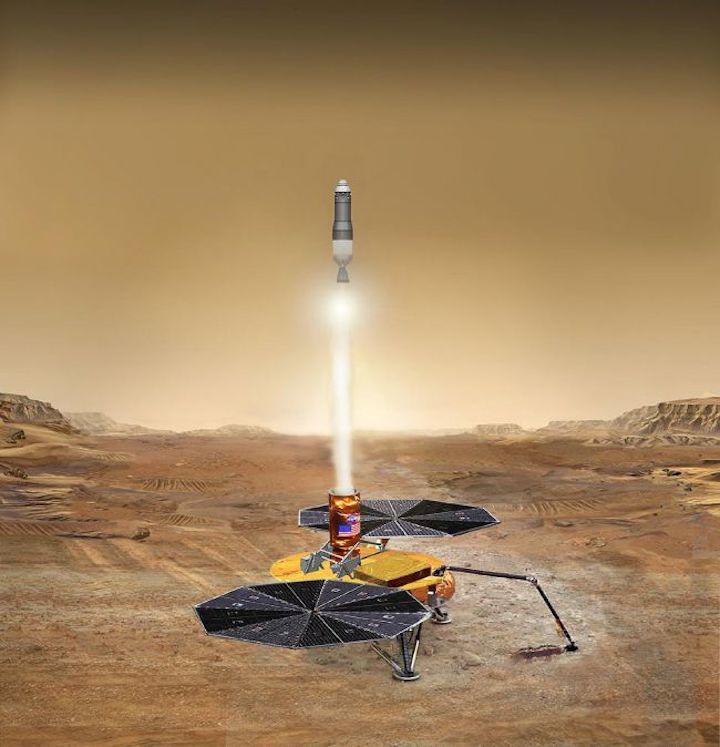
Pristine samples of the Red Planet will come down to Earth a little over a decade from now, if everything goes according to plan.
NASA and the European Space Agency (ESA) are working together on a highly anticipated Mars sample-return mission, which advocates say is the logical next step in our study of the Red Planet and its life-hosting potential.
"We need to bring [Martian] materials back and bring them into our laboratories," Brian Muirhead, of NASA's Jet Propulsion Laboratory in Pasadena, California, said during a presentation with NASA's Future In-Space Operations (FISO) working group last month.
Scientists in labs around the world will be able to analyze such samples much more precisely, and in many more ways, than a rover could do by itself on the Red Planet, helping us "to understand the history of Mars from a biological point of view," added Muirhead, who leads NASA's Mars sample-return campaign.
Researchers could even find signs of life in these Mars rocks, which are scheduled to return to Earth in 2031.
The NASA-ESA plan is not yet official, Muirhead stressed, and details are still being worked out. But here's a rundown of the concept, as it's currently conceived.
A sample-snagging rover
The campaign begins next July, with the launch of NASA's car-size Mars 2020 rover. The six-wheeled robot is scheduled to touch down in February 2021 inside the 30-mile-wide (50 kilometers) Jezero Crater, which hosted a river delta in the ancient past.
Mars 2020 (which will soon get a catchier moniker, via a student naming competition) will characterize Jezero's geology, hunt for signs of ancient life, demonstrate various technologies that could enable future human exploration of the Red Planet and perform a variety of other work, including the collection and caching of samples.
The rover carries 43 tubes for this purpose, five of which will be "references" that help researchers understand the environment the other tubes have been through, Muirhead said. So Mars 2020 could snag a maximum of 38 samples. Ideally, the rover will drop some of these in an accessible spot and keep others on its body, he added.
The next big step comes in 2026, with the launch of NASA's Sample Retrieval Lander (SRL) mission. SRL will include a stationary lander, the ESA-provided Sample Fetch Rover (SFR) and a rocket called the Mars Ascent Vehicle (MAV), which will be no more than 10 feet (3 meters) tall, Muirhead said.
The mission will touch down near the Mars 2020 landing site, and then SFR will hit the red dirt. This little robot will be smaller than NASA's golf-cart-size Spirit and Opportunity rovers, and it will leverage technology developed for ESA's life-hunting ExoMars rover, which is scheduled to launch toward the Red Planet next summer, just a week after Mars 2020 does.
The SFR will carry no science instruments, Muirhead said. Its lone job, as its name indicates, will be to get the samples dropped by Mars 2020 back to the lander, where they will be placed into the basketball-size Orbiting Sample container, or OS. (The sample-return campaign is complex, so it's even heavier on the acronyms than most space missions are.) If Mars 2020 does indeed hold on to some of its collected samples, this bigger rover could roll over to the lander as well.
"We've had to design the lander to accommodate both of these rovers coming and delivering tubes to us," Muirhead said.
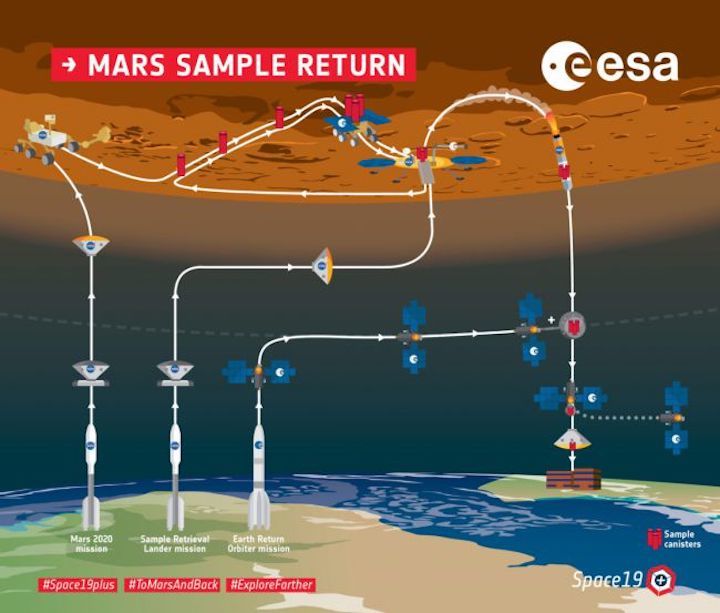
All of this will take time. The SRL surface mission is expected to last about eight months, with five months devoted to fetching, Muirhead said. Meanwhile, the MAV will be sitting there, waiting for its moment.
"It's got to survive the surface environment — mostly [low] temperature, but dust also," Muirhead said. "And then it's got to launch and deliver into Mars orbit. So, it's a challenging environment for rocket propulsion."
Spacecraft have launched from the surface of Earth's moon before — the Apollo missions did this multiple times — but no vehicle has ever left the much more massive Mars after landing there. So the MAV will make exploration history.
The MAV's specs have yet to be firmed up, Muirhead said. The sample-return team is looking at two options: a two-stage solid-propellant version, and a single-stage rocket that employs hybrid propulsion technology. A decision on the design should come by the end of the year, Muirhead said.
After taking the OS on board, the MAV will launch off the solar-powered lander and deploy the OS container into Mars orbit, at least 190 miles (300 km) above the planet's surface. It will be plucked out of the void by the third big piece of this grand plan: ESA's Earth Return Orbiter (ERO).
Like the SRL mission, ERO is scheduled to launch in 2026. ESA recently invited European companies to submit proposals to build the spacecraft.
"The mission is becoming a reality, and we are proud to give European industry the chance to join the challenge," ESA's Orson Sutherland, study manager for ERO, said in a statement.
The ERO will use electric propulsion and feature multistage detachable modules, leveraging technologies developed for the recently launched BepiColombo mission to Mercury, ESA officials said.
The European orbiter will install the newly captured OS inside a sterile containment system and then sterilize the joints of that system, likely using heat, Muirhead said. Such protocols will ensure that no Mars material leaks out during entry to Earth's atmosphere, potentially contaminating our planet.
The containment system will be placed inside a special entry vehicle, which will deploy from the ERO when the spacecraft nears Earth. The entry vehicle will barrel through our planet's atmosphere and slam into a playa, or dry lake bed, in Utah.
The team has designed the entry vehicle to operate without parachutes, relying instead on completely passive technologies. This strategy takes one big potential failure point out of play, Muirhead said.
The entry vehicle will experience impact forces of about 1,000 Gs if it hits the playa dirt, and perhaps 3,000 Gs if it's unlucky enough to slam into a rock, Muirhead said. (The acceleration at Earth's surface due to our planet's gravity is 1 G.)
"We're designing to both of those [scenarios]," he added.
The targeted landing date is 2031. Mars and Earth align favorably for interplanetary launches just once every 26 months. So, if the SRL and ERO aren't ready in 2026, the next opportunity would come in 2028, with a 2033 sample return to Earth.
"But beyond that, we really lose opportunities to do MSR [Mars sample return]," Muirhead said. "This is really a good opportunity, and we're working very hard to make this opportunity pay off."
Waiting for approval
Again, the campaign outlined above is just a concept at the moment. Though the 2020 federal budget request allocates some money to NASA for MSR development, the project is not officially on NASA's books yet, or those of ESA.
So we don't know how much all of this would cost. Muirhead said the team is treating the campaign as cost-constrained with a hard cap, though it's unclear what that cap will be.
MSR will be tough to pull off, requiring "multiple missions that will be more challenging and more advanced than any robotic missions before," ESA officials said in a different statement.
But the team thinks it's up to the challenge.
"The campaign and the design studies that we've been conducting with ESA are proceeding extremely well," Muirhead said. "We are prepared to proceed with this partnership to implement the objectives, pending approval from our respective funding agencies."
Quelle: SC
----
Update: 19.10.2020
.
THALES ALENIA SPACE SELECTED BY AIRBUS AS PARTNER TO THE MARS SAMPLE RETURN MISSION
A new decade of European exploration – to the Moon and Mars
Thales Alenia Space technology and expertise will contribute to the Earth Return Orbiter which will bring Red Planet samples back to Earth
Turin, October 14, 2020 – Thales Alenia Space, the joint venture between Thales (67%) and Leonardo (33%), has signed an Authorization To Proceed (ATP) with Airbus Defence and Space, prime contractor of the program, to contribute to the Earth Return Orbiter (ERO), the key element of the Mars Sample Return (MSR) Mission, which will be carried out through an international cooperation led by NASA. A first tranche, worth around €11 million, will be related to the B2 phase for a global contract value of around €130 million.
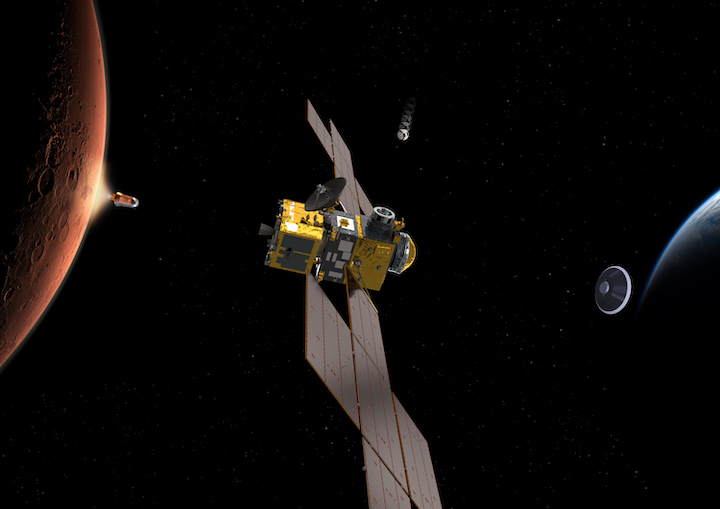
Thales Alenia Space will be responsible for:
- supplying the Communication System, consisting of the elements allowing the data transmission between Earth and ERO and Mars
- designing the crucial Orbit Insertion Module (OIM) and related thermo-mechanical, propulsion and electrical architectures
- the Assembly Integration and Test (AIT) phase for the Proto-Flight model of the ERO Spacecraft composing elements in its test facilities of Turin and Toulouse.
The Earth Return Orbiter spacecraft is composed by the Return Module and the Orbit Insertion Module. The Return Module (RM) hosts the NASA payload devoted to the capture of the Martian samples orbiting around Mars, of their containment and delivery to Earth. The Orbit Insertion Module (OIM) is an additional chemical propulsive stage, for inserting the spacecraft into Mars orbit. This module is crucial as he will allow to reduce the spacecraft velocity enabling the Martian gravity to capture ERO in a stable orbit. After the maneuver successfully completed, IOM will be separated from RM in order to save mass prior to the return to Earth.
Leonardo is also widely involved in Mars exploration missions, from the ExoMars 2016 and 2022 missions to the Mars Sample Return program. On this latter program, Leonardo is studying and designing the two robotic arms that will collect and transfer the Martian samples on the Mars Ascent Vehicle (MAV).

About the Mars Sample Return mission
By 2031, the Mars Sample Return mission will collect in situ Mars surface samples and bring them back for study in terrestrial laboratories. Firstly, the MSR Sample Retrieval Lander will descend to the planet’s surface carrying the Sample Fetch Rover (SFR) and the Mars Ascent Vehicle (MAV). SFR will collect the samples from the Martian surface that have been cached by the NASA Mars 2020 Perseverance rover and the SFR will transfer these samples into Mars Ascent Vehicle, a mini-rocket developed by NASA, which will launch them into Mars orbit. In that moment, the ERO spacecraft, that will be launched in 2026, will be ready to locate and capture the samples released by the MAV. After the capture, the samples will then be sealed in a biological containment system and placed inside an Earth Entry Vehicle. ERO will then leave Martian orbit and head back to Earth. When it arrives back in Earth orbit, it will release the Earth Entry vehicle that will be recovered on ground and the sample analyzed.
ABOUT THALES ALENIA SPACE
Drawing on over 40 years of experience and a unique combination of skills, expertise and cultures, Thales Alenia Space delivers cost-effective solutions for telecommunications, navigation, Earth observation, environmental management, exploration, science and orbital infrastructures. Governments and private industry alike count on Thales Alenia Space to design satellite-based systems that provide anytime, anywhere connections and positioning, monitor our planet, enhance management of its resources, and explore our Solar System and beyond. Thales Alenia Space sees space as a new horizon, helping to build a better, more sustainable life on Earth. A joint venture between Thales (67%) and Leonardo (33%), Thales Alenia Space also teams up with Telespazio to form the parent companies’ Space Alliance, which offers a complete range of services. Thales Alenia Space posted consolidated revenues of approximately 2.15 billion euros in 2019 and has around 7,700 employees in nine countries. www.thalesaleniaspace.com
Quelle: THALES
+++
Airbus to bring first Mars samples to Earth: ESA contract award

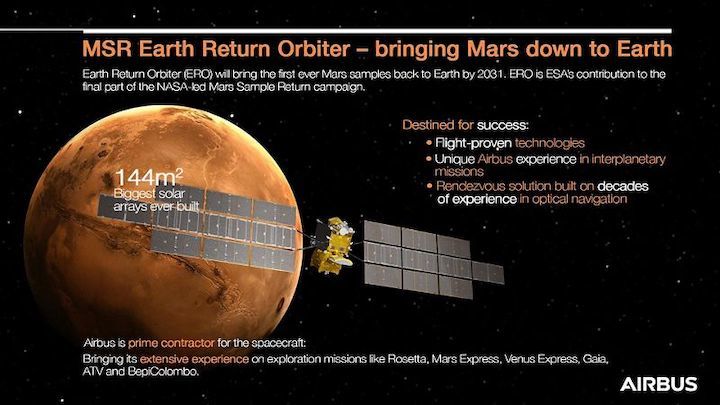
A new decade of European exploration – to the Moon and Mars
Airbus to design and build the Earth Return Orbiter (ERO) for Mars Sample Return (MSR) campaign
ERO will reach Mars orbit, capture orbiting samples launched from the Red Planet and bring them back to Earth
Toulouse, 14 October 2020 – Airbus has been selected by the European Space Agency (ESA) as prime contractor for the Mars Sample Return’s Earth Return Orbiter (ERO) – the first ever spacecraft to bring samples back to Earth from Mars. Mars Sample Return (MSR) is a joint ESA-NASA campaign and the next step in the exploration of Mars. ERO and the Sample Fetch Rover (SFR) are the two main European elements of MSR, both are set to be designed and built by Airbus. A manipulating arm, referred to as the Sample Transfer Arm (STA), that will transfer the samples from the SFR to the Mars Ascent Vehicle (MAV), is the third European contribution to the MSR program. The value of the ERO contract is € 491 million.
The five year mission will see the spacecraft head to Mars, act as a communication relay with the surface missions, perform a rendezvous with the orbiting samples and bring them safely back to Earth. Prior to launch from the Mars surface onboard the MAV, the Martian samples will be stored in sample tubes and collected by the SFR, for which Airbus has already commenced the study phase.
For ERO, Airbus will use its autonomous rendezvous and docking expertise built up over decades of experience in optical navigation, using technologies from the successful ATV (Automated Transfer Vehicle) and recent developments from JUICE, Europe’s first mission to Jupiter.
“We’re bringing the full force of our experience gained on Rosetta, Mars Express, Venus Express, Gaia, ATV, BepiColombo, and JUICE to ensure this mission succeeds. Bringing samples back to Earth from Mars will be an extraordinary feat, taking interplanetary science to a new level and Airbus is excited to take on this challenge as part of this joint international mission. ” said Jean-Marc Nasr, Head of Airbus Space Systems.
To be launched on an Ariane 6 in 2026, the 6 ton, 6 m high spacecraft, equipped with 144m² solar arrays with a span of over 40 m – some of the biggest ever built – will take about a year to reach Mars. It will use a mass-efficient hybrid propulsion system combining electric propulsion for the cruise and spiral down phases and chemical propulsion for Mars orbit insertion. Upon arrival, it will provide communications coverage for the NASA Perseverance Rover and Sample Retrieval Lander (SRL) missions, two essential parts of the MSR Campaign.
For the second part of its mission, ERO will have to detect, rendezvous with, and capture a basketball-size object called the Orbiting Sample (OS), which houses the sample tubes collected by SFR; all this over 50 million km away from ground control. Once captured, the OS will be bio-sealed in a secondary containment system and placed inside the Earth Entry Vehicle (EEV), effectively a third containment system, to ensure that the precious samples reach the Earth’s surface intact for maximum scientific return. It will then take another year for ERO to make its way back to Earth, where it will send the EEV on a precision trajectory towards a pre-defined landing site, before itself entering into a stable orbit around the Sun.
After landing, the samples will be transferred to a specialised handling facility where they will be quarantined. Once the sample tubes are opened, initial measurements will be taken to generate a detailed catalogue, enabling specific parts of the samples to then be targeted for specialist science investigations.
Airbus will have overall responsibility for the ERO mission, developing the spacecraft in Toulouse, and conducting mission analysis in Stevenage. Thales Alenia Space Turin will also have an important role, assembling the spacecraft, developing the communication system and providing the Orbit Insertion Module. The mission enabling RIT-2X ion engines will be provided by ArianeGroup.
About Mars Sample Return
Mars Sample Return is a set of three separately launched missions, which will together achieve the objective of returning Mars samples to Earth before the end of 2031.
The NASA-led Mars 2020 rover, known as Perseverance, was launched in July 2020 to land on Mars in February 2021. Perseverance will acquire Mars samples, cache them into sample tubes, and leave the tubes in one or more depots for later collection by the SRL mission and its European Sample Fetch Rover.
The NASA-led SRL is to be launched in 2026 and comprises a surface platform with a European robotic Sample Transfer Arm (STA), the Sample Fetch Rover (SFR), and a Mars Ascent Vehicle (MAV). The surface platform will land in the near vicinity of the sample tube depot in the Jezero crater. SFR will navigate, locate and collect the sample tubes, and return to the lander platform. The STA will transfer the sample tubes into the Orbiting Sample (OS) then load the OS aboard the MAV. The MAV will launch the OS into Mars orbit, where ERO will be waiting to rendezvous and capture it.
The ESA-led Earth Return Orbiter (ERO) is also to be launched in 2026 and will have onboard the NASA-led Capture, Containment and Return System (CCRS), which will handle and bio-seal the OS as well as provide the Earth Entry Vehicle (EEV). ERO will arrive in Mars orbit on time to provide communications coverage for the SRL entry, descent and landing, surface operations, and the MAV launch placing the OS into Mars orbit. ERO will have to detect, rendezvous with, and capture the OS. The OS will then be bio-sealed and transferred to the EEV before ERO heads back to Earth.
Upon approach to Earth, ERO will release the Earth Entry System on an Earth entry trajectory. After landing in the desert of Utah, the samples are transferred to a sample receiving and curation facility.
Quelle: AirbusSpace
----
Update: 29.03.2022
.
NASA to delay Mars Sample Return, switch to dual-lander approach
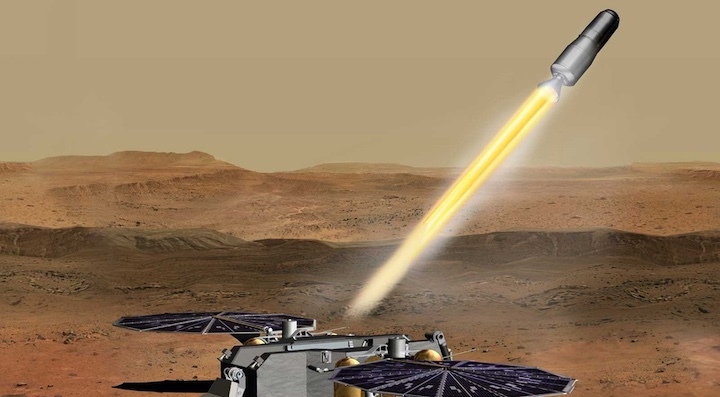
WASHINGTON — NASA plans to delay the next phase of its Mars Sample Return campaign and split a lander mission into two separate spacecraft to reduce the overall risk of the program.
At a March 21 meeting of the National Academies’ Space Studies Board, Thomas Zurbuchen, NASA associate administrator for science, revealed that NASA and the European Space Agency had agreed to revise the schedule and design for upcoming missions that will return samples being cached by the Perseverance rover to Earth.
Original plans called for the launch of both a NASA-led Sample Retrieval Lander and ESA-led Earth Return Orbiter in 2026. The lander, using an ESA-built rover, would collect the samples cached by Perseverance and load them into a rocket called the Mars Ascent Vehicle (MAV), which would launch them into orbit. The orbiter, using a NASA-provided collection system, would gather the samples and return them to Earth in 2031.
An independent review, though, recommended in November 2020 that NASA delay those future missions to 2027 or 2028 to provide a more reasonable development schedule. Another panel recommendation was for NASA to investigate turning the single Sample Retrieval Lander spacecraft into two separate landers, one carrying the rover and the other the MAV.
Zurbuchen told the Space Studies Board that NASA and ESA had agreed to split the Sample Retrieval Lander into two landers, which would now launch in 2028. “The Phase A analysis demonstrated that, frankly, the single lander breaks entry, descent and landing heritage. It is actually high risk,” he said.
The single-lander approach would require a larger heat shield, estimated to be 5.4 meters in diameter, which in turn would require a larger payload fairing for the rocket launching it. The design also had “unproven” entry, descent and landing capabilities and would require electric propulsion on the cruise stage to increase its payload performance.
A dual-lander approach, he said, could make use of the same landing system used by Perseverance and, before that, Curiosity. “It can be completed in the ’20s, just like we want to,” he said, and avoids the complexity of the larger design.
Both NASA and ESA agreed to adopt the approach as well as a schedule that would delay the launches of the two landers to 2028. The Earth Return Orbiter would launch in 2027, and the samples would return to Earth in 2033 under that revised schedule.
Zurbuchen said one lander, dubbed SRL1 and carrying the MAV and a robotic arm for sample transfer, would be built by the Jet Propulsion Laboratory because of “criticality and integration.” NASA had not yet decided on who would build the second lander, SRL2, which will carry the fetch rover. The decision, he said, would come by June, when the mission reaches a programmatic milestone called Key Decision Point B.
He did not discuss the cost implications of the schedule or design changes. Shortly before the launch of the Mars 2020 mission carrying the Perseverance rover, NASA and ESA officials estimated that the overall Mars Sample Return campaign would cost at least $7 billion. NASA will not make formal cost estimates of its future lander missions until the later Key Decision Point C review, although the agency’s fiscal year 2023 budget proposal, due for release March 28, may contain some additional details.
A complicating factor for Mars Sample Return plans is the delay in ESA’s ExoMars rover mission, which was to launch in September until the agency suspended its partnership with Roscosmos earlier this month after Russia’s invasion of Ukraine. ESA is now considering options for going forward with the mission that would delay its launch to at least 2026.
ESA officials said March 17 that those options could include a renewed partnership with NASA. Zurbuchen alluded to those comments in his remarks at the meeting but did not elaborate on any NASA role in ExoMars. “We are having a lot of discussion with our European colleagues that may or may not affect some of the discussions here related to ExoMars,” he said. “It’s up to them to talk about that.”
Quelle: SN
----
Update: 25.11.2023
.
Welsh technology to join search for life on Mars
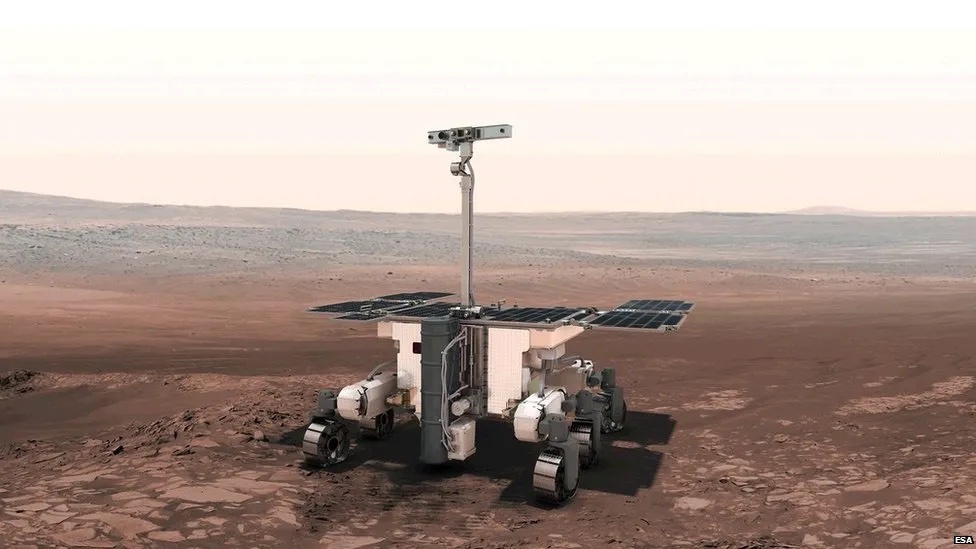
An artist's impression of the robot rover, which is designed to search for life on Mars
A scientific instrument built in Wales will lead the search for life on Mars at the end of this decade.
Enfys, meaning "rainbow" in Welsh, is an infrared spectrometer and will be assembled at Aberystwyth University.
It will be fitted to the European Space Agency's Rosalind Franklin rover, which launches to the Red Planet in 2028.
Enfys will work alongside the robot's other camera systems to identify the most promising rocks to drill and test for evidence of ancient biology.
The development cost of £10.7m ($13.4m) is due to be announced by science minister Andrew Griffith at the UK Space Conference in Belfast on Thursday.
The Welsh spectrometer will be replacing an instrument from Russia.
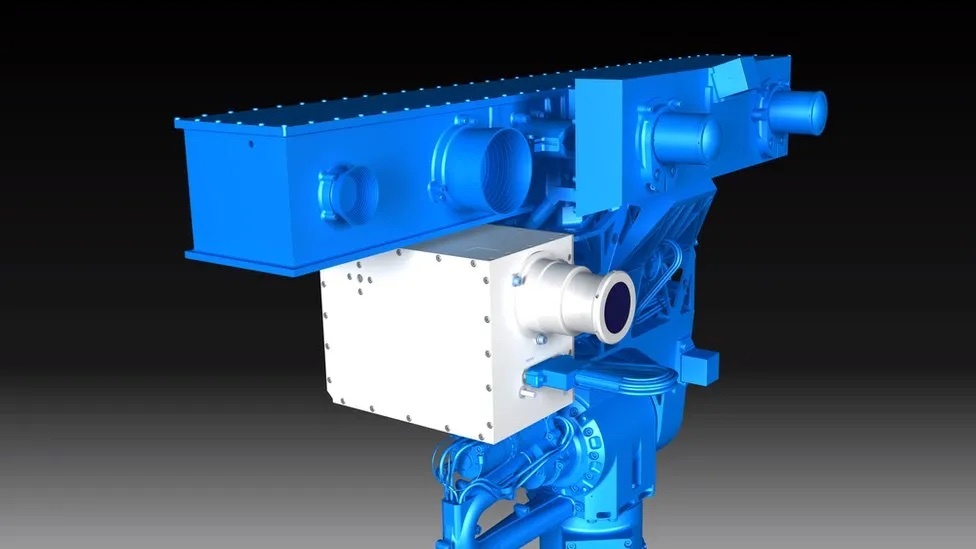
Moscow had previously been a partner on the mission but all its hardware was offloaded from the rover by Europe's space agency in protest at the war in Ukraine.
Enfys will be a direct replacement in terms of mass and volume but will carry a number of technical updates.
It will be hung from a mast holding the robot's camera platform, called Pancam, working in unison with high-resolution and wide-angle sensors to survey the Martian landscape.
"We will take a picture with Pancam and get a spectral measurement from Enfys," explained the university's Dr Matt Gunn.
"This will allow us to work out what kind of minerals are in the rocks," he told BBC News, adding: "We'll be interested in the sorts of minerals that formed in wet environments, the kinds of environments that could potentially have harboured life."
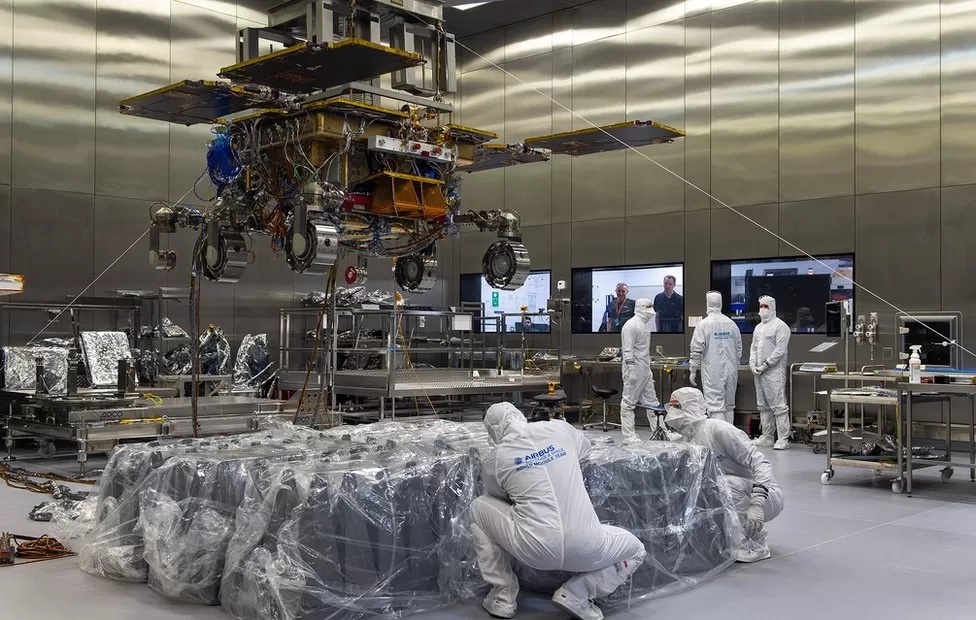
The rover project was first approved in 2005
Rosalind Franklin is designed to do something no previous Mars rover has attempted, which is to drill and retrieve rock samples from more than a metre underground. It is thought any evidence of present or, more likely, past life will be found beneath the planet's surface, away from the destructive effects of space radiation.
The six-wheeled Franklin robot was first approved way back in 2005. The project has since gone through a number of redesigns and funding crises. The fallout over Ukraine is just the latest setback and means the mission will not get to the launchpad for another five years now.
Much larger Russian components than the infrared spectrometer also need to be substituted with European-sourced elements, not least the rocket mechanism that will land Rosalind Franklin softly at a near-equatorial site on Mars known as Oxia Planum.
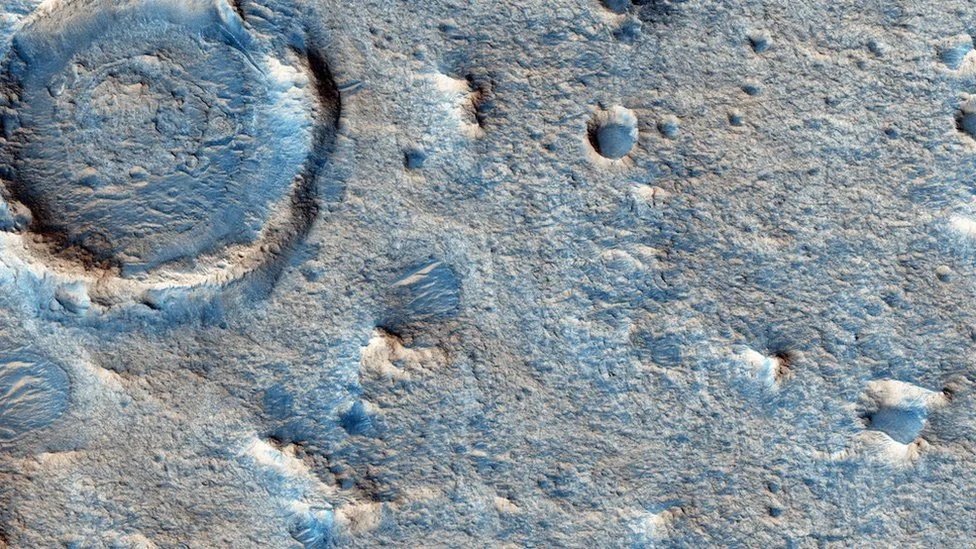
The rover will be aimed at Oxia Planum where clay minerals may preserve evidence of past life
The late inclusion of Enfys does have the benefit that its performance requirements can be revisited.
An example is the range of infrared wavelengths in which it will be working.
Previously, there was going to be a gap in sensitivity between what Pancam could detect and what the old Russian spectrometer could see.
Enfys will be set up so that there is a slight overlap.
"We'll now have spectral continuity from Pancam into the infrared, which is light we can't see with our own eyes," said Enfys team member Dr Claire Cousins from the University of St Andrews in Scotland.
"This mission will be very focused on looking for clay minerals, which have the greatest likelihood of preserving organic matter. And these minerals have very specific absorption bands in the infrared that Enfys will be able to see but that Pancam won't."
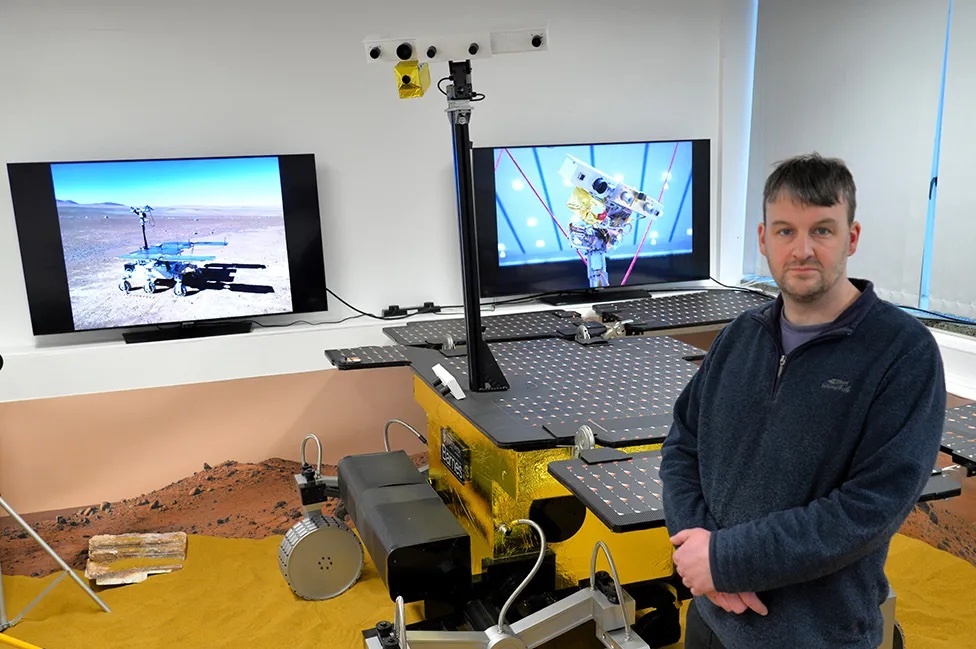
Dr Matt Gunn will lead Enfys development at Aberystwyth University
Aberystwyth University will be assisted on the new build by the Mullard Space Science Laboratory at University College London, STFC RAL Space in Harwell, Oxfordshire, and Qioptiq Ltd in St Asaph, Denbighshire.
The £10.7m being spent on Enfys brings the total UK investment in the Rosalind Franklin rover to £377m. With other members of Esa and help from the US space agency (Nasa), the total cost of the robot project will be well in excess of £1bn.
Dr Paul Bate, chief executive of the UK Space Agency, said: "The UK-built Rosalind Franklin rover is a truly world-leading piece of technology at the frontier of space exploration. It is fantastic that experts from the UK can also provide a key instrument for this mission, using UK Space Agency funding.
"As well as boosting world-class UK space technology to further our understanding of Mars and its potential to host life, this extra funding will strengthen collaboration across the fast-growing UK space sector and economy."
